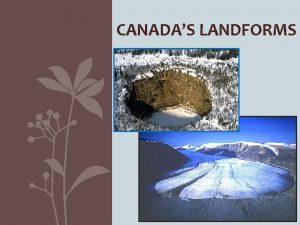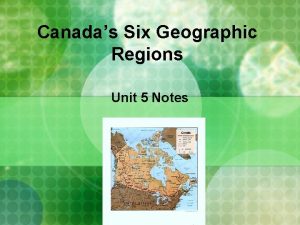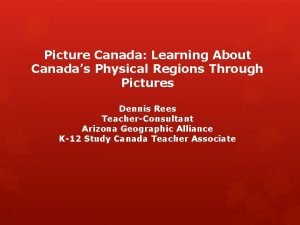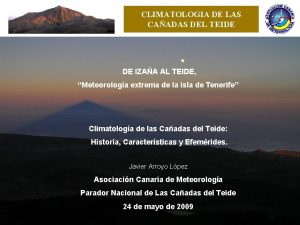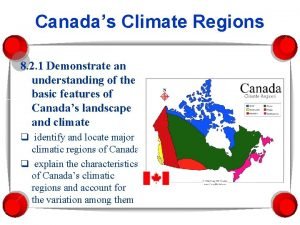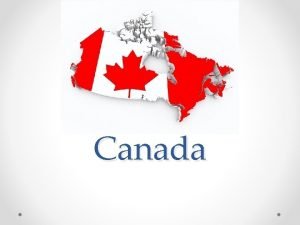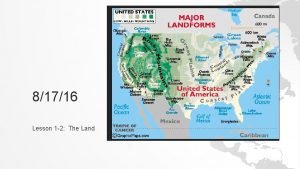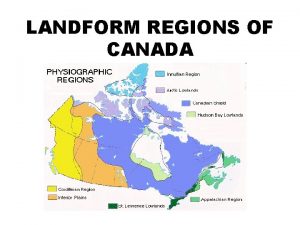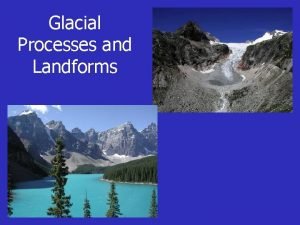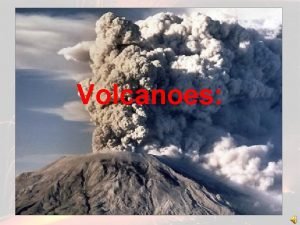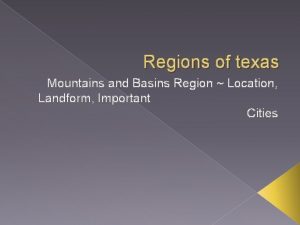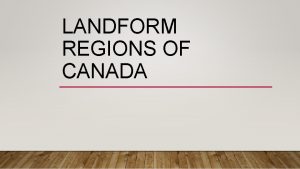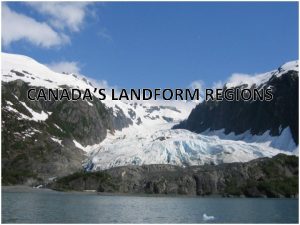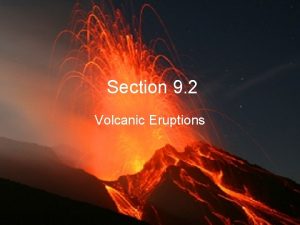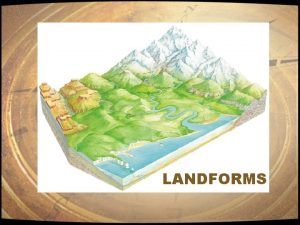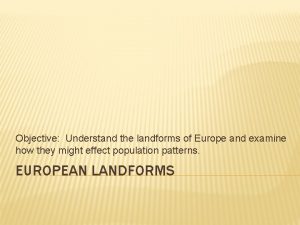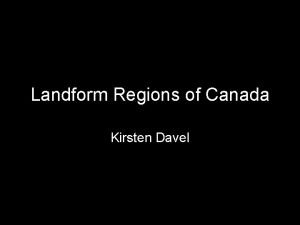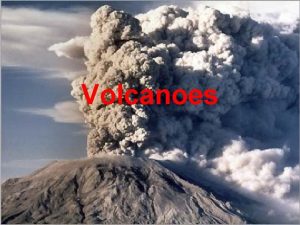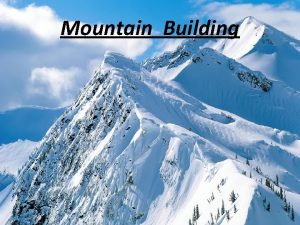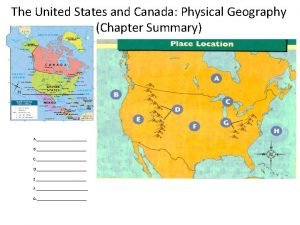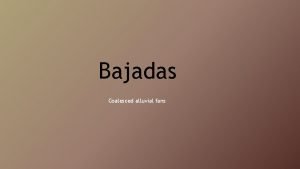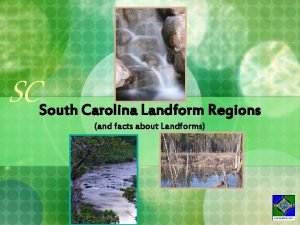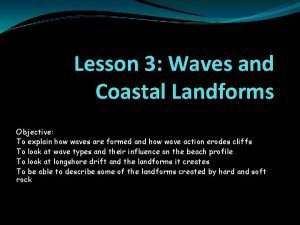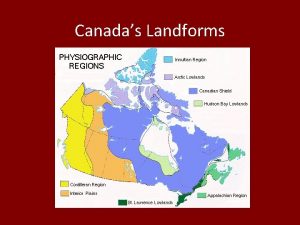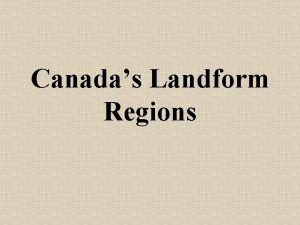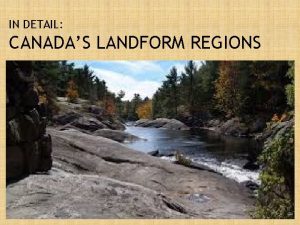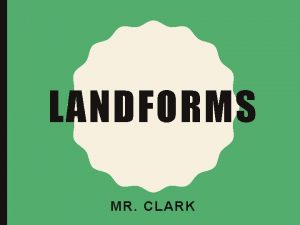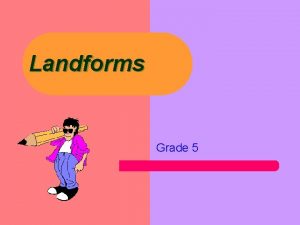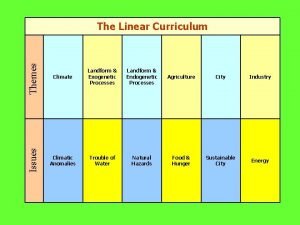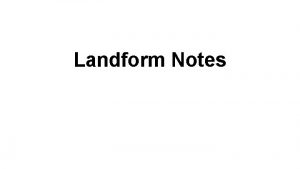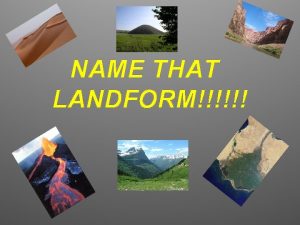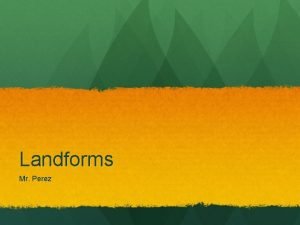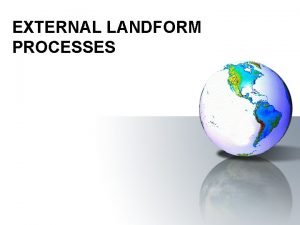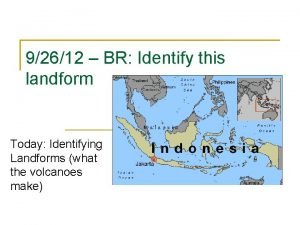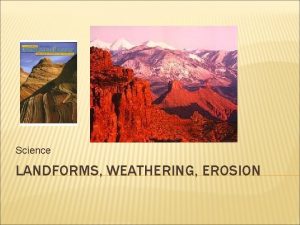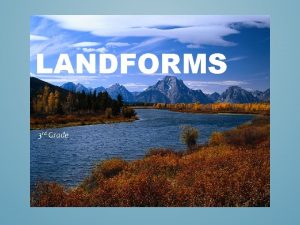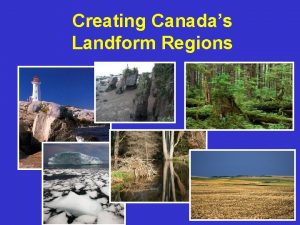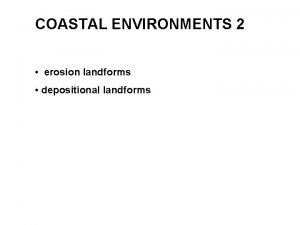CANADAS LANDFORMS WHAT IS A LANDFORM A landform





























- Slides: 29

CANADA’S LANDFORMS

WHAT IS A LANDFORM? • A landform is any physical feature of the Earth’s surface having a characteristic, recognizable shape, produced by natural causes. • What kinds of natural causes? (Hint: Think about what we learned in Unit 2!) • Landforms include major features (e. g. continents, ocean basins, plateaus, mountain ranges)… • …and minor features (e. g. hills, valleys, slopes, drumlins, dunes).

LANDFORMS IN CANADA • Canada is made up of three distinct types of landforms: • Canadian Shield • The Highlands • The Lowlands • Within these landforms there are smaller sub-regions, each of which have their own characteristics. • All the regions form a pattern that can explain how they were created over time.

CANADIAN SHIELD • The Canadian Shield is the foundation of Canada’s land. It spans more than half of Canada and some parts of the United States. • Formed of hard igneous rock from which all the other areas were created. • Some parts are nearly 4 billion years old from the Pre-Cambrian era.

CANADIAN SHIELD

THE LOWLANDS • There are three lowland regions in Canada, surrounding the Shield: • The Interior Plains • The Great Lakes-St. Lawrence Lowlands • The Hudson Bay-Arctic Lowlands • The bedrock of the Lowlands was formed by the eroded material of the Canadian Shield that was deposited by the seas and ice that once covered many parts of Canada. • Thus, the Lowlands are made of what and by what?

LOWLANDS

THE HIGHLANDS • Canada also has three highland areas to the east, north and west of the Shield and lowland areas. • The Appalachian Mountains • The Innuitian Mountains • The Western Cordillera • Made of, in part, sediments from the Canadian Shield combined with metamorphic rock. • Why are these highlands mainly located on the east, west, and north coastlines of Canada?

HIGHLANDS

RELATED READING TEXTBOOK: Landforms, p. 50 -53 …and continue to the next slide!

A CLOSER LOOK: THE CANADIAN SHIELD

• The Canadian Shield was formed by tectonic forces (mountain building) and was at one time far higher than any mountains currently on Earth! • Over time, the Shield was worn down by erosion, and now is nearly flat, with rounded hills of rock. • It is also made up of many different minerals and metals, which are found in the igneous and metamorphic rock within the Shield.

• Due to these mineral deposits, many towns and cities have been built on top of it (e. g. Sudbury ON, Thompson MN. ) • The Shield is not very good for farming, as the soil is thin on top of the rock, because of the glacial erosion. • Water also does not drain from it very well as the Shield is rock.

A CLOSER LOOK: THE LOWLANDS

1: INTERIOR PLAINS • This region stretches from the 49 th parallel (U. S. -Canada border) up to the Arctic Ocean (2700 km north) • The soil found in this region is fertile and deep, and allows the growth of many crops in the Prairie region. (Canada’s “breadbasket”) • The region was also shaped by glaciation, and lakes such as Lake Winnipeg were formed as a result of glacial forces.

2: GREAT LAKES-ST. LAWRENCE LOWLANDS • South of the Canadian Shield, this region is made up of two different parts, which meet at one point near Kingston. • The southern part is the Great Lakes Lowlands. They are mostly flat and made of sedimentary rocks left by glaciers. • Even the Great Lakes were gouged out of the landscape by glacial movement! (What processes caused this? ) • The northern half, the St. Lawrence Lowlands, was instead formed by faulting. (What kind of plate movement could have created this? ) • Two divergent plates left a valley in between, which flooded with water, resulting in the St. Lawrence River!

• The warm climate and good soil of the Great Lakes-St. Lawrence region allow for excellent farming. • These factors have also allowed the growth of large cities, which are situated on waterways. (Why are many cities here? ) • About 50% of our population live in this region, and 70% of Canada’s manufacturing takes place here!

3: HUDSON BAY-ARCTIC LOWLANDS • The Northern regions of Canada are also relatively flat and formed from glacial deposition and sediment. • The harsher climate of this region makes it difficult for agriculture, as the ground remains frozen in many areas, year round.

• The Hudson Bay Lowlands are located near the southwestern shore of Hudson Bay and James Bay. • The Arctic Lowlands refer to the islands scattered across Canada’s far north.

A CLOSER LOOK: THE HIGHLANDS

1: THE APPALACHIAN MOUNTAINS • These mountains are the oldest highland region in Canada, formed about 300+ million years ago. (What era? ) • Tectonic folding forced the layers of rock upwards as the North American plate collided with the plates of Europe and Africa during the formation of Pangaea.

• Millions of years of erosion has worn the peaks of the Appalachians down into rolling hills and mountains. • During the last ice age, the weight of the glaciers on the region forced the plate downwards, and allowed the flooding of the lower areas by the ocean. • As a result, the coastline of the area is filled with deep inlets and bays.

2: THE INNUITIAN MOUNTAINS • These mountains were formed in the Mesozoic era as the North American plate pushed northward. • Since these mountains are younger than the Appalachians, they have not been worn down as dramatically. • Due to their location and climate, the mountains are barren as trees cannot survive on them.

Mineral deposits in this region have been found, but are not yet profitable to mine due to the remoteness of their location and difficulties extracting them.

3: THE WESTERN CORDILLERA • This region, on the Western coastline of Canada, is made up of tall, rugged mountains. These features tell us that the mountains here are still geologically young. • The collision of the Pacific and North American plate led to the uplifting of the region into several mountain ranges. • The Rocky Mountains are just one of these several ranges.

• The large cities in this region (Victoria, Vancouver, etc. ) are built in the flatter coastal area. • Tourist towns, such as Banff and Jasper, offer tourists a view of the beauty of the mountains. • Glaciers also still exist in the Northern and elevated areas of the region.

MISCONCEPTIONS OF THE CORDILLERA REGION • The mountains in this area run in a North-South direction, and there actually 3 different mountain ranges in this region: • The Eastern Mountains (Rocky & Columbia Mountains) • The Interior Plateaus (Okanagan Valley, etc. ) • The Coast Mountains • The Western Cordillera is therefore not only the Rocky Mountains, but several other ranges too!

EARTHQUAKES IN CANADA? • The movement of the North American and Pacific plates makes the west coast of Canada the most active earthquake zone in the country! • Over 100 earthquakes of a magnitude of 5 or more have been recorded in the ocean west of Vancouver Island in the past 70 years.

RELATED READING TEXTBOOK: Landforms, p. 50 -53
 Canadas landforms
Canadas landforms What economic system is canada
What economic system is canada Whats canadas longest river
Whats canadas longest river Electromagnetismo
Electromagnetismo Canadas 5 regions
Canadas 5 regions Physical regions in canada
Physical regions in canada Temperatura cima teide
Temperatura cima teide Canadas head of state
Canadas head of state Canadas climate
Canadas climate 90 of the canadian population lives within
90 of the canadian population lives within Examples of landforms
Examples of landforms Largest landform region in canada
Largest landform region in canada Glacial processes
Glacial processes What continent is this
What continent is this Volcanic landform
Volcanic landform Map of mountains and basins region in texas
Map of mountains and basins region in texas Landform regions of canada
Landform regions of canada Industries in the interior plains
Industries in the interior plains Landforms in the southwest
Landforms in the southwest Volcanic landform
Volcanic landform Is the hudson bay saltwater
Is the hudson bay saltwater Landforms europe
Landforms europe How was the hudson bay arctic lowlands formed
How was the hudson bay arctic lowlands formed Different types of body of water
Different types of body of water Volcanic landform
Volcanic landform A mountain is a large landform that stretches
A mountain is a large landform that stretches Define landform
Define landform Bajada landform
Bajada landform South carolina landforms
South carolina landforms Wave cut notch diagram
Wave cut notch diagram
